First Solar, coming off a strong quarterly earnings report and with its stock up more than 400 percent in 18 months, is now moving to take advantage of Japan’s surging solar market.
The Arizona-based company, which has developed a number of mammoth utility-scale plants where it deploys its cadium-telluride thin-film panels, is looking to take advantage of Japan’s turn from primarily focusing on residential solar to building large PV plants.

“Japan is adopting a progressive approach by incorporating clean, safe, renewable sources of power in its plans to address the gap created by idle nuclear power,” CEO James Hughes said in a statement. “First Solar has proven solutions to support Japan’s vision of energy security and economic growth, and we will continue to invest here as part of our strategy to develop sustainable solar markets.”
And here’s an interesting twist: Along with the announcement that it would invest $100 million to develop plants in Japan, First Solar said it was hooking up with JX Nippon to develop and manufacture crsystalline silicon solar panels in Japan based on the technology it got when it acquired TetraSun this past spring.
The thinking when First Solar sprang for TetraSun was that it would use the panels, capable of producing at higher efficiency than the CaTe thin-film panels, for rooftop installations. So First Solar could be looking to make a mark in that sector in Japan, too; a healthy feed-in tariff has fed big growth in installations in the past year in the country.
First Solar had this to say about the TetraSun possibilities it will pursue with JX Nippon:
Developed with a unique and revolutionary PV cell architecture, and an innovative manufacturing process combining the consistency of conventional crystalline Silicon technology with the high performance of high-end mono-crystalline technologies, the First Solar offering allows discerning Japanese consumers’ access to technology that is high on efficiency, performance & quality.
Japan launched a generous feed-in tariff (FIT) program in July 2012 – post-Fukushima, of course – to get solar going after a period in which it largely forsaken the technology.
According to industry tracker Solarbuzz, over the first three quarters of calendar year 2013, Japan was forecast to install more PV capacity than during the entire three-year period spanning 2010 to 2012. And a declining proportion was expected to be on rooftops: Until the end of 2012, 97 percent of PV capacity was on rooftops, but during the first eight months of 2013, the ground-mount segment accounted for 27 percent of new capacity. Earlier this month, too, Kyocera began commercial operations of the largest PV plant in the nation, a 70-megawatt installation in Kagoshima City.